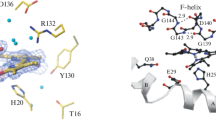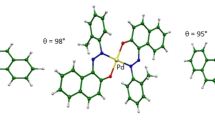Abstract
Biliverdin (BV) structure was analyzed by using NMR techniques and unrestricted density function theory simulations to explain the incapacity of BV to build coordination complex(es) with Cu2+ in dimethyl sulfoxide, which was confirmed by UV-Vis, EPR and NMR spectroscopy. NMR showed that N atoms are protonated in all four pyrrole rings. The structure is stabilized by two hydrogen bonds between NH moieties and carbonyl oxygens from opposite terminal pyrrole rings, and by the bending of propionyl chain with carboxyl group out of the plain toward central position of BV. The simulations of deprotonated BV, which builds copper complexes in water and chloroform as described previously, showed a different conformation and organization of hydrogen bonds. Taking into account that deprotonation represents a critical step in coordinate bonds formation, the protonation of an additional N atom may represent a key difference between the interactions of BV with copper in different solvents.




Similar content being viewed by others
References
Korać J, Todorović N, Zakrzewska J, Žižić M, Spasojević I (2018) The conformation of epinephrine in polar solvents: an NMR study. Struct Chem 29:1533–1541
Watermann T, Elgabarty H, Sebastiani D (2014) Phycocyanobilin in solution - a solvent triggered molecular switch. Phys Chem Chem Phys 16:6146–6152
Sailofsky BM, Brown GR (1987) Solvent effects on the photoisomerization of bilirubin. J Chem 65:1908–1916
Nam J, Lee Y, Yang Y, Jeong S, Kim W, Yoo JW, Moon JO, Lee C, Chung HY, Kim MS, Jon S, Jung Y (2018) Is it worth expending energy to convert biliverdin into bilirubin? Free Radic Biol Med 124:232–240
Dimitrijevic MS, Bogdanović Pristov J, Žižić M, Stanković DM, Bajuk-Bogdanović D, Stanić M, Spasić S, Hagen W, Spasojević I (2019) Biliverdin-copper complex at physiological pH. Dalton Trans. https://doi.org/10.1039/c8dt04724c
Krois D, Lehner H (1993) Helically fixed chiral bilirubins and biliverdins: a new insight into the conformational, associative and dynamic features of linear tetrapyrrols. J Chem Soc Perkin Trans 2:1351–1360
Lightner DA, Holmes DL, McDonagh AF (1996) On the acid dissociation constants of bilirubin and biliverdin. pKa values from 13C NMR spectroscopy. J Biol Chem 271:2397–2405
Lightner DA, Holmes DL, McDonagh AF (1996) Dissociation constants of water-insoluble carboxylic acids by 13C-NMR. pKas of mesobiliverdin-XIIIα and mesobilirubin-XIIIα. Experientia 52:639–642
Sugishima M, Sakamoto H, Higashimoto Y, Noguchi M, Fukuyama K (2003) Crystal structure of rat heme oxygenase-1 in complex with biliverdin-iron chelate. Conformational change of the distal helix during the heme cleavage reaction. J Biol Chem 278:32352–32358
Reichardt C (2003) Solvents and solvent effects in organic chemistry. Wiley-VCH Verlag GmbH & Co, Weinheim
Sóvágó I, Harman B, Kolozsvári I, Matyuska F (1985) Complex-formation and redox reactions of bilirubin and biliverdin with zinc(II), cadmium(II) and copper(II) ions. Inorg Chim Acta 106:181–186
Berlec A, Štrukelj B (2014) A high-throughput biliverdin assay using infrared fluorescence. J Vet Diagn Investig 26:521–526
Shang L, Rockwell NC, Martin SS, Lagarias JC (2010) Biliverdin amides reveal roles for propionate side chains in Bilin reductase recognition and in holophytochrome assembly and photoconversion. Biochemistry 49:6070–6082
Mukerjee P, Ostrow JD (1998) Effects of added dimethylsulfoxide on pKa values of uncharged organic acids and pH values of aqueous buffers. Tetrahedron Lett 39:423–426
McDonagh AF, Phimster A, Boiadjiev SE, Lightner DA (1999) Dissociation constants of carboxylic acids by 13C-NMR in DMSO/water. Tetrahedron Lett 40:8515–8518
Rubino JT, Berryhill WS (1986) Effects of solvent polarity on the acid dissociation constants of benzoic acids. J Pharm Sci 75:182–186
Kurtin WE, Enz J, Dunsmoor C, Evans N, Lightner DA (2000) Acid dissociation constants of bilirubin and related carboxylic acid compounds in bile salt solutions. Arch Biochem Biophys 381:83–91
Ostrow JD, Celic L, Mukerjee P (1988) Molecular and micellar associations in the pH-dependent stable and metastable dissolution of unconjugated bilirubin by bile salts. J Lipid Res 29:335–348
Li M, Xiao Z, Xiang H, Lu Z (1997) Unusual solvent effect on absorption spectra of nonplanar dodecaphenylporphyrins with different substituents. Spectrochim Acta A Mol Biomol Spectrosc 53:1691–1695
Moussa F, Kanoute G, Herrenknecht C, Levillain P, Trivin F (1988) Electrochemical oxidation of bilirubin and biliverdin in dimethyl sulfoxide. Anal Chem 60:1179–1185
Lu G, Lin W, Fang Y, Zhu W, Ji X, Ou Z (2011) Synthesis and electrochemical properties of meso-phenyl substituted copper corroles. Solvent effect on copper oxidation state. J Porphyrins Phthalocyanines 15:1265–1274
Balch AL, Mazzanti M, Noll BC, Olmstead MM (1993) Geometric and electronic structure and dioxygen sensitivity of the copper complex of octaethylbilindione, a biliverdin analog. J Am Chem Soc 115:12206–12207
Dorazio SJ, Halepas S, Bruhn T, Fleming KM, Zeller M, Brückner C (2015) Singlet oxygen oxidation products of biliverdin IXa dimethyl ester. Bioorg Med Chem 23:7671–7675
Feliz M, Ribó JM, Salgado A, Trull FR, Vallès MA (1989) On the 1H NMR spectra of biliverdins with free propionic acid substituents. Mönatsh Chem 120:445–451
Kaplan D, Navon G (1982) Studies of the conformation of bilirubin and its dimethyl ester in dimethyl sulphoxide solutions by nuclear magnetic resonance. Biochem J 201:605–613
Pretsch E, Bühlmann P, Badertscher M (2009) Structure determination of organic compounds. Springer-Verlag, Berlin
Bates RG (1973) Determination of pH: theory and practice. Wiley & Sons, New York
Hathaway BJ, Billing DE (1970) The electronic properties and stereochemistry of mono-nuclear complexes of the copper(II) ion. Coord Chem Rev 5:143–207
Garribba E, Micera G (2006) The determination of the geometry of Cu(II) complexes. J Chem Educ 83:1229–1232
Elleb M, Meullemeestre J, Schwing-Weill MJ, Vierling F (1982) Spectrophotometric study of copper(II) chloride complexes in propylene carbonate and in dimethyl sulfoxide. Inorg Chem 21:1477–1483
Willett RD, Chang K (1970) The crystal structure of copper(II) chloride bis(dimethylsulphoxide). Inorg Chim Acta 4:447–451
Kozlowski H, Kowalik-Jankowska T, Jeżowska-Bojczuk M (2005) Chemical and biological aspects of Cu2+ interactions with peptides and aminoglycosides. Coord Chem Rev 249:2323–2334
Meng R, Becker J, Lin FT, Saxena S, Weber SG (2005) Binding of copper(II) to thyrotropin-releasing hormone (TRH) and its analogs. Inorg Chim Acta 358:2933–2942
Mukerjee P, Ostrow JD, Tiribelli C (2002) Low solubility of unconjugated bilirubin in dimethylsulfoxide--water systems: implications for pKa determinations. BMC Biochem 3:17
Nogales D, Lightner DA (1995) On the structure of bilirubin in solution. J Biol Chem 270:73–77
Acknowledgments
We are thankful to Prof. Miloš Mojović at EPR Laboratory, Faculty of Physical Chemistry, University of Belgrade for recording EPR spectra and to Ljiljana Stojanović from School of Biological and Chemical Sciences, Queen Mary University of London, for her great help in calculating and discussing theoretical results obtained using the UDFT.
Funding
This work was supported by the Ministry of Education, Science and Technological Development of the Republic of Serbia (III43010). This article is based upon work from COST Action CA15133 FesBioNet, supported by COST (European Cooperation in Science and Technology).
Author information
Authors and Affiliations
Corresponding authors
Ethics declarations
Conflict of interest
The authors declare that they have no conflict of interest.
Additional information
Publisher’s note
Springer Nature remains neutral with regard to jurisdictional claims in published maps and institutional affiliations.
Electronic supplementary material
ESM 1
(PDF 499 kb)
Rights and permissions
About this article
Cite this article
Dimitrijević, M.S., Žižić, M., Piccioli, M. et al. The conformation of biliverdin in dimethyl sulfoxide: implications for the coordination with copper. Struct Chem 30, 2159–2166 (2019). https://doi.org/10.1007/s11224-019-01354-5
Received:
Accepted:
Published:
Issue Date:
DOI: https://doi.org/10.1007/s11224-019-01354-5




